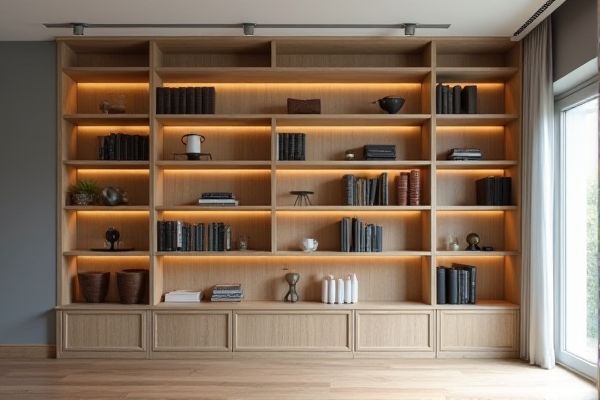
Deep shelves provide greater storage capacity and can hold bulkier items, while shallow shelves are ideal for easy access and displaying smaller objects without overwhelming the space. Discover how to choose the perfect shelf depth to optimize your storage and decor by reading the rest of the article.
Table of Comparison
| Feature | Deep Shelves | Shallow Shelves |
|---|---|---|
| Storage Capacity | High storage volume, ideal for bulk items | Lower storage volume, suitable for small items |
| Accessibility | Harder to reach items at the back | Easy access to all items |
| Space Utilization | Maximizes vertical space | Optimizes front space and visibility |
| Best Use Case | Warehouse storage, large inventory | Retail displays, quick access items |
| Cost | May require more structural support, higher cost | Lower cost, simple installation |
Understanding Deep Shelves vs Shallow Shelves
Deep shelves provide ample storage space and support for heavier items, making them ideal for organizing larger objects or bulkier goods. Shallow shelves, with their limited depth, allow for easy visibility and quick access to smaller items, enhancing organization in tighter spaces. Understanding the differences between deep and shallow shelves helps you optimize storage efficiency and select the right solution for your specific needs.
Space Utilization: Deep vs Shallow Shelves
Deep shelves maximize vertical and horizontal space, allowing you to store larger or more items efficiently, which is ideal for bulkier belongings or extensive collections. Shallow shelves offer easier access and visibility, making them suitable for frequently used items or smaller spaces where efficient organization is key. Choosing between deep and shallow shelves depends on your storage needs and the balance you want between capacity and accessibility.
Storage Capacity Comparison
Deep shelves offer significantly greater storage capacity compared to shallow shelves, accommodating larger items and allowing for more efficient organization of bulky or tall products. Shallow shelves are better suited for smaller or frequently accessed items, optimizing visibility and ease of reach but limiting overall storage volume. Choosing the right shelf depth enhances storage efficiency by aligning your space with the size and quantity of stored goods.
Accessibility and Convenience
Deep shelves offer ample storage but can make it difficult to access items placed at the back, reducing overall convenience. Shallow shelves enhance accessibility by keeping all items within easy reach, ideal for frequently used objects. Your choice should balance storage capacity with how often you need to retrieve items quickly and effortlessly.
Organizational Flexibility
Deep shelves enhance organizational flexibility by allowing varied storage configurations that accommodate both large and small items efficiently. This adaptability supports dynamic inventory management, optimizing space utilization and workflow within warehouses or retail settings. Shallow shelves, while easier to access, limit storage customization and reduce the ability to reconfigure layouts based on changing organizational needs.
Visual Appeal and Aesthetics
Deep shelves create a bold visual impact by providing substantial storage space that can accommodate larger decorative items, adding depth and dimension to a room. Shallow shelves offer a minimalist and sleek aesthetic, ideal for displaying small, curated collections without overwhelming the space. Choosing between deep and shallow shelves depends on the desired balance between functionality and visual openness in interior design.
Ideal Uses for Deep Shelves
Deep shelves are ideal for storing bulky items such as large kitchen appliances, storage bins, and stacks of linens, maximizing vertical space without clutter. They provide ample room for organizing oversized books, large art supplies, or extensive tool collections, ensuring easy access and visibility. These shelves enhance storage efficiency in garages, pantries, and utility rooms where space demands practical, heavy-duty solutions.
Ideal Uses for Shallow Shelves
Shallow shelves are ideal for displaying small items such as spices, mugs, or decorative collectibles, making them perfect for kitchens, living rooms, or offices where space efficiency is crucial. Their compact depth enhances visibility and accessibility without overwhelming the room, facilitating quick item retrieval. Shallow shelves also work well in narrow spaces or hallways, maximizing storage without compromising walkway clearance.
Choosing the Right Shelf Depth for Your Space
Selecting the ideal shelf depth depends on your storage needs and available space, with deep shelves (typically 12-16 inches) offering ample room for bulkier items and shallow shelves (6-10 inches) providing a sleek, space-saving solution for smaller objects. Deep shelves maximize storage capacity in larger rooms or closets, while shallow shelves enhance visibility and accessibility, making them perfect for tight spaces or display areas. Balancing functionality and aesthetics ensures you optimize your space effectively, whether for books, decor, or everyday essentials.
Maintenance and Cleaning Considerations
Deep shelves require more effort and time for maintenance and cleaning due to the difficulty in reaching items located at the back, increasing the risk of dust accumulation and clutter. Shallow shelves facilitate easier access, making routine cleaning faster and more effective, which helps maintain a tidier environment. Selecting shelf depth should consider the frequency of use and the ease of upkeep to optimize cleanliness and organization.
 homyna.com
homyna.com